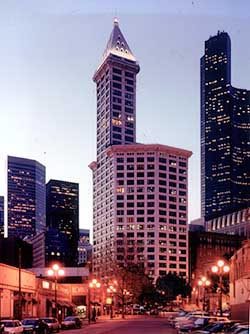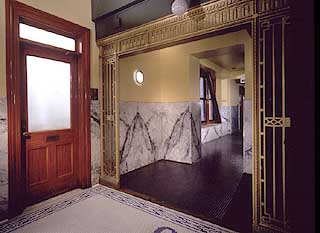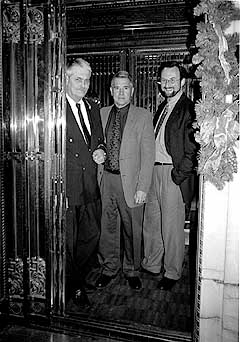|
Subscribe / Renew |
|
|
Contact Us |
|
| ► Subscribe to our Free Weekly Newsletter | |
| home | Welcome, sign in or click here to subscribe. | login |
Architecture & Engineering
| |
January 5, 2000
New life for a landmark
Special to the Journal
It was only a matter of time for the Smith Tower. For decades, Seattle's first skyscraper has been beloved by preservationists, historians and the public while it stood waiting for the perfect match with developer and architect. Just in time for the millennium, Samis Foundation and Mithun Partners arrived.
Samis will celebrate the comprehensive renovation and upgrade of the 86-year-old office building on Jan. 27. The renovated 38-story landmark, originally designed by Gaggin & Gaggin, is now up to modern office standards and seismic safety. The original architect, who aimed for fire safety along with height, would be pleased.

|
New interior and exterior lighting have been switched on. The tower, once the tallest building west of the Mississippi, has renewed command of the Seattle skyline and an inner glow to match. With new entrances and storefronts, it also meets the street with confidence.
The entrance vestibule is encased with new slabs of onyx, imported from Pakistan to replace the original Mexican stone, long since gone. Because the original application could not be found, this portal was one of the few public areas where the design team was truly free to enrich the look.
With this comprehensive renovation, the eagerness of owner and designer to preserve the character of the Smith Tower was put to the test. They were answerable to no less than four separate jurisdictions charged with maintaining the historic integrity of the landmark. The owners needed approval from the Seattle Landmarks Preservation Board to make any changes in the interior lobbies.
"The Landmarks Board became almost a design review board," said Williams.
In addition, the Pioneer Square Historic District had to approve changes to the exterior, as did the U.S. Department of the Interior. And the state has an easement on the facade.
Preservationists have long recognized the significance of the ornate, hand-operated elevators of the Smith Tower, which have special landmark status of their own. They dominate the ground floor lobby even more brightly now, with operators greeting and waving to riders as they come and go. The ornate plaster ceiling, with its familiar ranks of headdressed American Indians, is now lit by hanging light fixtures designed to match the originals. In one deliberate departure from the historic character of the lobby, a metal and onyx reception desk swings out from an original service niche. But this and a few rattan chairs placed along the lobby only distract from the real action along the elevator wall.
The shining brass elevator cages still race up and down behind the glass with vertigo-inducing speed. But now the latest technology controls their floor-to-floor stops, and the operators need only open and shut the doors.
|
Project
Owner:
Architect:
Completion date for structural renovation:
Completion date for tenant improvements:
Cost of renovation (inclusive):
Structural engineer:
Mechanical contractor:
Electrical engineer:
Interior finishes, public areas:
Lighting designer, interior:
Lighting designer, exterior:
General contractor: |
The most sweeping changes to the tower follow the general trend toward fewer and larger tenants in downtown office buildings. At one time, the Smith Tower had more than 500 mostly one- to two-person offices. The first tenants were brokers, shippers, suppliers and even a consulate or two. In more recent years, the mix has included local government employees, many serving the King County court system.
But the renovated and fully leased Smith Tower has only 25 tenants, according to property manager Genni Reilly. Many occupy one floor, and some occupy more than five floors.
But the building has not become a homogeneous environment. Two of the largest current tenants are the Sisters of Providence, a not-for-profit and the states oldest corporation, and go.com, an Internet company. Their respective offices are studies in contrast. The first has the serene camaraderie of a museum office, where sweeping views compete with breathtaking artwork on the walls. In the second, youthful employees flow easily through the lobby and stare intently at computers in floors divided by sculptural cut-out forms and a colorful, geometric floor pattern.

|
In his role as developer, Justin looks at the building with renewed interest. Most of the Samis trustees, born and raised in Seattle, had known the building as the tallest in the city, and shared his interest. "They are personally thrilled to see this building given a new lease on life and begin its second century," said Justen.
When GE Capital foreclosed on the building and accepted sealed bids from potential buyers, Samis won by a narrow margin, and the sale closed in December of 1997. King County's leases on two thirds of the building were running out that spring, bringing opportunities for major improvements. Talk of air conditioning led to massive electrical upgrades, and the project quickly evolved into a full renovation with seismic reinforcement.
One of several keys to making a redevelopment project work was parking, and the foundation owned three other properties on the same block. There was another critical advantage in its ownership of the adjoining Florence Building, a former theater and home of the long-running "Angry Housewives," now also renovated with the help of Mithun Partners. In addition to leasable space in the front, the Florence now houses the transformer vaults, chillers and compressors that support the mechanical systems of the Smith Tower. This arrangement has allowed Samis to renovate the ornately tiled basement of the Smith Tower for reuse as a fitness center.
The ideal office lighting, especially for computer use, is indirect, according to Williams. But you can only have that with high ceilings. The high, concrete, coffered ceilings of the Smith Tower have been preserved, and the new suspended light fixtures give them a glow that can only be fully appreciated by looking up at the tower from the street at night.
To keep the ceiling free of duct work, the consultant team devised a system for air conditioning stacked in ducts and framed beside columns. But cabling is another matter. Trays circulating around ceilings of the building carry wiring. The design team decided to make cabling a feature, exposing it and making it as interesting as possible. The decision paid off esthetically as well as practically. Tenants, according to Justen, love the accessibility and ease of rearranging the space to suit their needs.

|
This strategy required the construction of a new outer wall of the Smith Tower, an element that required extensive review and approval. The new wall is designed to reflect an original inset wall on the north facade. Glass fiber-reinforced gypsum is used to emulate terra cotta color and texture, and the design team made use of castings from the existing window sills to blend historic and reinforcing elements.
Interpretation was also required in restoring street level storefronts, said Mithun project manager Wolf Saar, since they had been modified for years. The architect designed recessed doorways in the street-level storefronts with decorative tiling underfoot. Anodized aluminum window frames designed to mimic others from the period complete the renewal.
Because leasing of office space at the Smith Tower has been wildly successful, Samis found room in the Smith Tower budget for exterior lighting. "You can do a lot with light," said Justen. He liked Mayor Paul Schell's idea about lighting up bridges to celebrate the millennium. "Why not do that for Seattle's greatest skyscraper?"
One of Justen's favorite features is a series of glass prisms imbedded in the sidewalk along Second Avenue, emitting light at night from the basement below. One night just before the holidays, he spotted some visiting teenagers practicing rock star moves in the glow. It confirmed his feelings about the challenges of renovating the Smith Tower and several neighboring buildings.
"Its really a pleasure," he said
Clair Enlow can be reached by e-mail at clair@clairenlow.com.
Previous columns:
- Renovation charts a new course, 09-01-1999
- Designed to transport, 07-01-1998


